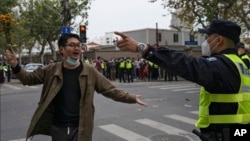China eased some of its pandemic rules on Monday but affirmed its “zero COVID” strategy even as protests erupted throughout the country against the restrictions, and some demanded the resignation of President Xi Jinping.
The government made no mention of the demonstrations, the biggest show of opposition to the ruling Communist Party in decades, but the slight relaxation of the rules appeared aimed at quelling the demonstrations.
Chinese police were out in force in the streets of Beijing and Shanghai on Monday in an effort to prevent more protests against the government’s COVID restrictions.
In Hong Kong Monday evening, students at the Chinese University held a small-scale vigil to show support for protesters on the mainland.
Over the weekend, protesters shouted, “Lift the lockdown!” in a city in China’s western region, while across the country in Shanghai, the financial center, protesters held up blank sheets of white paper as a quiet show of dissent.
A Shanghai resident told VOA he no longer fears the spread of the infection because it has become normalized.
He said, "I just eat whatever I want to eat, and do whatever I want to do. What is there to worry about? It's a cold. It's normal."
Others in Shanghai chanted, “Xi Jinping! Step down! CCP! Step down!" in referring to the Communist Party. Police detained dozens of protesters, driving them away in police vans and buses, although the exact number was not clear.
At Peking University in Beijing, graffiti read, "We don't want lockdown or control; we want freedom. We don't want PCR testing; we want to eat.”
Xi’s “zero COVID” policy has sharply limited infections through stringent lockdowns that have disrupted everyday life in the country of 1.4 billion people. Protests erupting at locations around the country appear to indicate that many Chinese have grown weary of the lengthy quarantines and widespread testing.
The Beijing city government said Monday it would no longer set up gates to block people from entering apartment compounds where infections have been found. It, however, made no mention of a deadly fire last week in the western Xinjiang region that spawned protests over whether firefighters and victims trying to escape a building were blocked by locked doors and other anti-infection controls.
"Passages must remain clear for medical transportation, emergency escapes and rescues," the China News Service quoted a city epidemic control official as saying.
The government blamed “forces with ulterior motives” for linking the fire to the strict COVID measures.
In Urumqi, where the deadly fire occurred, a witness to last week’s blaze told VOA on Monday that firefighters had difficulty entering the building because of the government’s anti-COVID policies.
“The fire exit door on the top floor was locked. Then they came down using the elevator to the first floor,” the witness, a Uyghur who asked to remain anonymous fearing Chinese government retaliation, told VOA.
“Unfortunately, that exit was also locked by the government officials because of the mask.”
People in Xinjiang use the word "mask to" refer to the Chinese government’s zero-COVID policy.
China’s government denies that firefighters had any difficulty accessing the building and has accused “forces with ulterior motives” for linking the fire to COVID-19 measures.
In addition to easing the rules in Beijing, officials in Guangzhou, the southern manufacturing and trade metropolis that is the biggest hotspot in China's latest wave of infections, said some residents will no longer be required to undergo mass testing.
Officials in Urumqi and another city in the Xinjiang region in the northwest, said that markets and other businesses in areas deemed at low risk of infection would reopen this week, and public bus service would resume.
The “zero-COVID” policy aims to isolate every infected person and has helped China to keep its case numbers, as a percentage of its overall population, lower than those in the United States. As a result, millions of Chinese have been confined to their homes for up to four months.
On Monday, China recorded 40,437 new cases, while the U.S. figure on Sunday was 41,997.
Despite the protests and relaxation of some rules, the ruling party newspaper People's Daily called for its anti-coronavirus strategy to be carried out effectively, indicating Xi's government has no plans to change course.
"Facts have fully proved that each version of the prevention and control plan has withstood the test of practice," a People's Daily commentator wrote.
US reaction to China lockdowns
In Washington, the White House said the Biden administration supported peaceful protests.
“Whether it's the people protesting in Iran or China or anywhere else around the world, nothing has changed about the president's firm belief in the power of democracy and democratic institutions and how important that is," National Security Council spokesman John Kirby said.
He said the Biden administration is monitoring the events in China closely.
The U.S. Mission in China said it has regularly raised concerns with the Chinese government about the COVID restrictions and their effect on Americans living in or visiting the country.
“We encourage all U.S. citizens to keep a 14-day supply of medications, bottled water, and food for yourself and any members of your household,” U.S. officials said.
In Washington, the U.S. National Security Council said it supports the right of Chinese people to peacefully protest the COVID restrictions.
"We’ve long said everyone has the right to peacefully protest, here in the United States and around the world. This includes in the PRC [People's Republic of China]," a spokesperson said, adding, "We think it’s going to be very difficult for the People’s Republic of China to be able to contain this virus through their zero-COVID strategy."
The State Department said the United States, rather than imposing a zero-COVID policy, is "focused on what works and that means using the public health tools, like continuing to enhance vaccination rates and making testing and treatment easily accessible."
VOA’s Mandarin service also contributed to this report. Some material in this report came from The Associated Press and Reuters.







